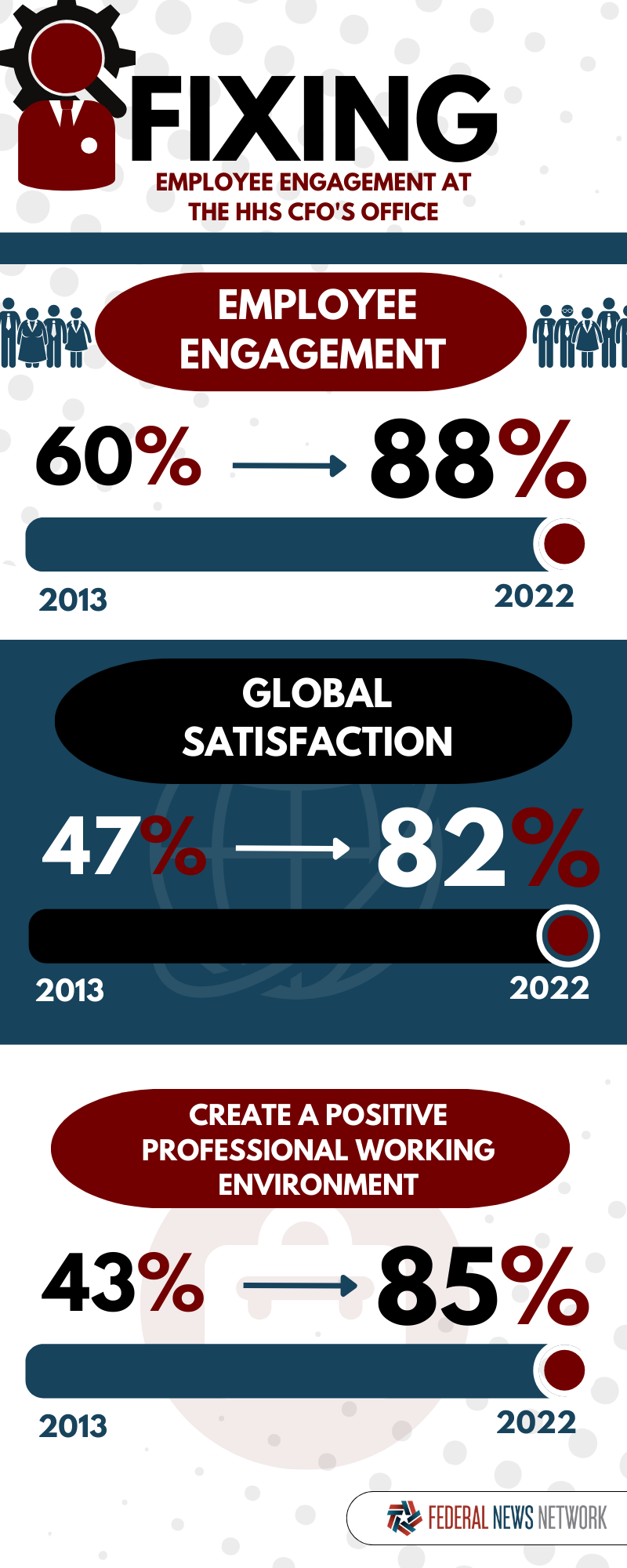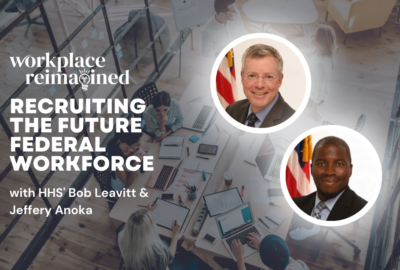From burnout, unhappiness to thriving, attractive, how HHS’ CFO’s office turned the tide
Sheila Conley, the deputy CFO at the Department of Health and Human Services, said over the last decade her office’s management team has improved how it manages,...
Stop me if you’ve heard this one before. The executive saw her office’s dismal employee viewpoint scores and said, “We have to change our culture. Our workforce is too important.”
Too often what comes next is a short-lived, ineffective effort because either the executive leaves, gets distracted, loses interest or the workforce doesn’t buy-in and the entire initiative to change the culture falls like a house of cards.
But what if this wasn’t the “change the culture” version of the movie Groundhog Day? What if Bill Murray, or in this case the Department of Health and Human Services Office of the Chief Financial Officer, actually didn’t rinse and repeat the day over and over again with the same dismal results?
Luckily for HHS, Sheila Conley, the deputy CFO at HHS, looks nothing like Bill Murray, and broke the Groundhog Day cycle of failures.
Over the last decade, Conley and her team turned the CFO’s office from a place where burnout and unhappiness reigned into an example of a thriving, healthy and attractive workplace.
“About 10 years ago, one of the issues that we recognized is that while we were accomplishing most of our significant things like a clean audit opinion and meeting reporting deadlines, that work was being done on the backs of a few people at senior levels, really through heroic efforts. But that was not a sustainable way to build an organization,” Conley said in an interview with Federal News Network. “At that point in time, we realized we need to do something. We really needed to look at our organization, look at our workforce, make sure folks understood what’s expected of them, what’s expected at every level, whether you’re an executive, a manager or a staff member, and we really undertook a comprehensive review of our mission, and how we were going to accomplish that mission through our workforce.”
HHS’ employee viewpoint scores were at a low point with engagement, global satisfaction and creating a positive professional working environment all well below governmentwide averages. Conley said things were so bad in 2013 that she was worried the “wheels would come off the bus,” and her office was approaching “mission failure.”
Today that decade of focus with an eye toward culture change has paid off across the board.

Employee viewpoint scores across all categories have significantly improved. And more importantly, the HHS CFO’s office is now a destination and a training ground for employees to achieve their career goals.
“When we started out our employee engagement was under 60%. It’s now today at 88%. That’s about a 50% increase over time. So we’re very proud of that. In terms of global satisfaction, that’s gone from 47%, back in 2013 to now it’s at 82%. So about a 75% increase in that score,” she said. “Then the belief and action and this I think is critical for the future, meaning folks in our organization think these results are going to be used to improve a culture improve the workplace environment, create a positive professional working environment, that’s gone from 43% in 2013 to 85% in 2022. So that’s about a 98% increase.”
It’s not the FEVS scores alone that tell the story of this change. Conley said continuous feedback from employees including “exit” interviews tell a much different story than a decade ago.
“I’m happy to report that many of our people leave because they’re getting promotions, and they’re staying within the HHS family, which is great. And we have a lot of people that come back, and others move on to other organizations or retire,” she said. “We have had very little turnover, which is actually very surprising, since about 2016 timeframe. I am pleasantly surprised by that and very pleased. We’ve been able to hire and actually fill vacancies that we had pre-pandemic during the pandemic, so we’re bringing on a whole new infusion of talent and energy and skills.”
HHS’ long-term, unfunded effort
Conley quickly admits that not everything is rosy and the employees aren’t without complaints.
“These are static scores, so how do we assure ourselves that this will continue?” she said. “There’s a couple of things that we’ve done and we’ve continued to build on these things over time. We began executive coaching for both our executives, our managers and supervisors in 2016. We brought on board an administrative officer who’s charged with employee engagement. That was the first time we developed the Office of Finance FEVS action plan so that we could track very closely the negative scores, and we could look at the highest negatives every year that come back through the individual questions and responses and try to solve them.”
This long-term effort didn’t include extra funding and it spanned across three presidential administrations, meaning keeping the momentum was hugely important to the initiative’s success.
Conley said each step of the process to change the culture took patience, time, planning and, of course, input from the employees.
“Feedback, people say, is a gift. But it was a painful gift to receive. Once we acknowledged the extent and pervasiveness of our issues, then we, as the leadership team, had to agree on a couple of things. We knew we had to be intentional that workforce engagement and developing people,” she said. “Improving a culture doesn’t happen by accident, just because you have great individuals working for you, you have to, as an organization, be quite intentional and deliberate about making this a priority to it’s a continuous process. It doesn’t change overnight. You can’t change culture in a short period of time. It’s continuous effort. You’re never done. The environment changes, the world changes, our people change and the expectations of our organizations change. So it’s a continuous process and a continuous feedback loop is critical.”
The FEVS scores provided annual updates on their progress. But Conley said that wasn’t nearly enough feedback to drive the type and long-term change her management team was looking for.
She said managers had to respond to the survey, getting more granular about how they were doing and ensuring employees were fully engaged in the efforts. Conley said she and her leadership team meets with staff, meets with small groups and conducts “exit” interviews with employees who leave the organization to identify and address problems or obstacles.
“As executives, we meet twice a week to talk about things that are happening, to keep a pulse on things. The management team is meeting with executives and managers, we have one-on-ones very frequently,” Conley said. “We’re probably better connected now than even when we were here in person pre pandemic because we have to be more intentional about making sure we’re engaging in, have eyes on folks and ears and that sort of thing. There’s a variety of mechanisms that we use, going out with surveys and gauging the interest in this data and using those feedback loops.”
Managers received coaching
One of the first things Conley’s team did was bring in executive coaching for the leadership team, managers and supervisors in the 2016 timeframe.
“My theory was if we can bring on board key executives who have a shared mindset about the organizational development, individual development and growth and where we wanted to go as an organization, then that would cascade down through the management tier and the general workforce,” she said. “I will tell you in terms of employee engagement and how we’ve been able to improve our results and improve the culture over time, it’s a combination of things. You need the tone at the top, you need that mood in the middle with the management team and then you need the buzz at the base. It all works together. It’s upward, it’s downward and it’s across.”
The training was so effective, she expanded it to the entire Office of Finance workforce a year later. The coaching helps employees at all levels offering advice, counsel to help solve problems and act as a sounding board to help solve problems or challenges.
“All of our folks become better versions of their professional self. As folks are able to work with their coaches, they become much better colleagues. That is really how you start expanding this net and really having individuals improve,” Conley said. “But as it expands beyond us to our organization and our colleagues, that’s how you change the culture. The culture is more than one person. It’s a whole feel of an organization.”
HHS’ changing mindset
The idea is through the coaching, the strategic planning and paying attention to the continuous feedback cycle, using the FEVS as a starting point each year, the culture and mindset of the entire team starts to turn.
Another “game changer” for the office happened in 2018 when the Office of Finance’s entire leadership team attended a leadership development and organizational transformation session.
“It really helped us both professionally and personally to change our mindset. You go to a lot of these training and development things and you can talk about changing behaviors and after about two months or so you’re like, ‘Oh, I don’t do that. I’m back to my old behaviors.’ This is a different philosophy that really our leadership team and our workforce has really ascribed to where you change the mindset about how you approach your work and your colleagues. That changes behaviors and generate results,” Conley said. “So that training we sent our whole leadership team to in 2018 was a game changer. We were so successful that the following year we had our entire office go through those sessions.”
Throughout this goal to change the Office of Finance’s culture, Conley emphasized the goal was never just to improve the FEVS scores. Those are a by-product of the continuous effort to work with and help employees achieve success individually and as a group.
“If you’ve got that mission out there and you’ve got smart, hardworking, well-intended people who are qualified for their positions and want to work together to get that important mission done, good things can happen,” she said. “Recognizing where you have problems and blind spots, and organizations can have blind spots and people can have blind spots, so that’s where coaching and different tools and resources that are available to help us all see our blind spots. You just have to be able to confront and realistically assess where you are as an organization and work through it. There is hope, but you really have to prioritize and be intentional. It’s a long term investment of your time. But the return on the investment is well worth it, and I wouldn’t do anything differently.”
The HHS Office of Finance’s story isn’t one of heroics or luck. It’s one any leader, in any organization can easily heed with the right commitment, dedication and recognition of the end goal is making sure your employees are satisfied and supported.
Nearly Useless Factoid
The start of the theme tune from ‘Mission: Impossible’ starts with two beats followed by two half-beats. If translated into Morse Code — two dashes, two dots — it spells out the letters M and I.
Source: Quite Interesting
Copyright © 2025 Federal News Network. All rights reserved. This website is not intended for users located within the European Economic Area.
Jason Miller is executive editor of Federal News Network and directs news coverage on the people, policy and programs of the federal government.
Follow @jmillerWFED







